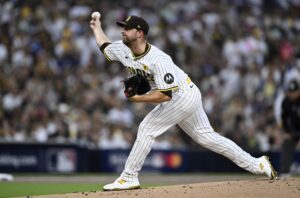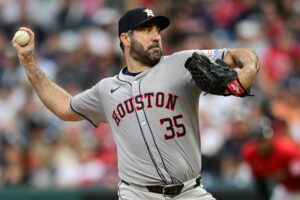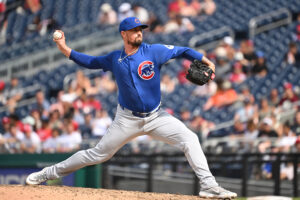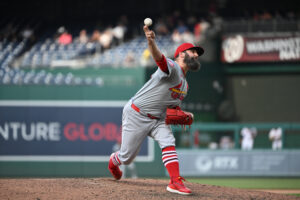Has anyone ever wondered why pitchers and catchers report to spring training before position players? This can sometimes be a point of curiosity for fans both old and new. Per USA Today, this spring training is no different as pitchers and catchers are widely scheduled to report by February 15th or 16th while position players are on the 20th or 21st. It might only be five days, but the first spring training games start on February 24th, giving pitchers and catchers more time to prepare than position players, as well as build their relationships.
One might ask, “What difference do five days make?” or “Why are pitchers and catchers more important than position players?” Well, these are loaded questions with answers that are far from simple. However, the difference in days comes down to this simple statement – the relationship between pitchers and catchers is of the utmost importance in baseball.
Why The Pitcher Catcher Relationship Is So Important
The ‘Battery’
The term “battery” or “batterymates” is a baseball colloquialism used to describe the pitcher-catcher tandem. While not as widely used anymore, this is pretty common terminology for baseball fans as the phrase is used in broadcast booths. Like many other terms in history, “battery” was first used during the 19th century in reference to firepower or artillery weapons. What is most interesting about the relationship between a pitcher and a catcher is that their roles are the most important on a team.
One breakdown in communication, a misstep by the catcher, or a loss of focus by the pitcher can determine an entire season. The two positions are supposed to be one of stabilization and force both on and off the field. There are very few teams in history to have great success without good pitching from a pitcher and good defense from a catcher. Their roles are connected in many ways. A pitcher’s statistics can be boosted with not only a good catcher behind the plate, but one that they have a good relationship with.
Why The Bond Is So Important
Baseball has become very analytical. Driven by technology and data, there is so much about the on-field product in the sport that can be measured. Teamwork is a term that seemingly has many uses but cannot be measured by numbers or data. While baseball is a team sport, the type of teamwork it requires is very different than that of hockey or basketball.
The purest form of teamwork in this sport, or any sport, is between a pitcher and a catcher. Not only do catchers have to know what pitchers are thinking, but they also have to know all of the pitcher’s strengths, weaknesses, and tendencies, and know their pitches. They must know what an individual pitch does, how it moves, and where it will end up. Another important aspect of this is pitch calling. Since the catchers know the pitcher’s repertoire so well, they are often charged with determining what the pitcher should throw next. Through a system of signs, the catcher and pitcher must agree on what pitch to throw, and its location. They spend countless hours and days refining the system and their communication throughout the season. Catchers have arguably the hardest job in baseball because they must do this with every pitcher on the team.
Communication and Trust
Pitchers, on the other hand, must have total and complete trust in the catcher they are pitching to. They must trust the catcher can effectively catch any pitch at any moment, regardless of location or speed. There have been several instances in baseball history where a pitcher and catcher do not agree on what to throw, ending in a wild pitch or passed ball that allows runs to score in crucial moments. Pitchers and catchers must essentially become best friends to grow this level of trust and communication over time. Over the course of one broadcast, there will be many shots into the dugout of the pitcher and catcher sitting together and talking. Whether it is about the signs, sequences, or miscommunication, this is a constantly evolving relationship. This is part of the reason why midseason trades for starting catchers are not common.
If a baseball viewer has seen a pitcher bounce a curveball in the dirt on a 1-2 count, this is not always an accident. Pitchers will even do this with runners on base. Sometimes they just lose control of the pitch. Other times, the catchers will be the ones to call for that pitch, knowing it can possibly result in a strikeout. The pitcher might feel comfortable throwing that pitch even with a runner on base because he trusts the catcher to make the right play and block the pitch in the dirt. Having a sound defensive catcher behind the plate can go a long way in improving the pitcher’s performance. It also goes a long way in building greater trust in the catcher throughout the season.
Personal Catchers
Out of this trust and communication comes the notion of a personal catcher. A team usually carries two catchers, sometimes three. There are certain pitchers on a staff who just naturally work better with the backup catcher. Usually, a personal catcher is the team’s backup, who may only play once or twice per week. While the primary catcher is working with all pitchers, the backup may be working with one or two starters. Examples of this include New York Yankees ace pitcher Gerrit Cole with Kyle Higashioka in 2020 and 2021, Clayton Kershaw with Austin Barnes, and so on.
Maybe the backup catcher is more defensive-minded, maybe he is the pitcher’s best friend, or anything else, but this is still a very important bond that can make or break a pitcher’s performance. Clear success requires a very high level of teamwork, communication, and trust between pitchers and catchers. A lot of a team’s success depends on how well batterymates can work together. There have been several pitcher-catcher tandems that have made up some of the sport’s greatest relationships.
Best Pitcher Catcher Relationships in Baseball
This Yadier Molina tribute narrated by Adam Wainwright is awesome!🥹pic.twitter.com/hHZbRFazo4
— MLB Deadline News (@MLBDeadlineNews) September 5, 2022
There have been several fantastic batteries in baseball history. However, there is one that stands out, which is Adam Wainwright and Yadier Molina. They are arguably the best pitcher-catcher duo in baseball. With a combined 328 games started, that is the most in history and a record that might not ever be broken. Molina debuted in 2004, playing 19 years as arguably the best defensive catcher in baseball for the St. Louis Cardinals. Wainwright, 41, is entering his 18th and final season after debuting all the way back in 2005.
Other notable batteries in baseball history are Mickey Lolich and Bill Freehan of the Detroit Tigers from 1963-1975. Whitey Ford and Yogi Berra started 212 games together for the Yankees as perhaps the most star-studded battery in history. Jorge Posada and Andy Pettitte are two members of the Core Four who made 194 starts together. They helped lead the Yankees to five World Series titles. Even legendary closer Mariano Rivera pitched in 598 games with Posada behind the plate. More recently, Madison Bumgarner and Buster Posey are two core members of a dynastic San Francisco Giants team. They made 228 starts together while winning three World Series titles in five years in the 2010s.
Final Thoughts
There you have it. The bond between catchers and pitchers is arguably the most crucial relationship in sports. It is one that requires constant teamwork, communication, and trust. This is one of the biggest reasons why pitchers and catchers report to spring training earlier than position players. It is to establish that relationship early on while working out together, studying pitching together, and establishing a repertoire. Simply put, the bond between the two is as tight-knit and unique as any other you’ll see in sports.
When asked about Yadier Molina by Bill Ladson of MLB.com, Wainwright remarks, “ He has been more than a friend and teammate to me. He has been a brother to me. The guy I have gotten so close with…I don’t want to imagine life without him. I never even thought about it. He’s my catcher, man.” If that does not speak enough about the bond between catcher and pitcher, then I don’t know what does.
Main photo:
Jeff Curry – USA Today Sports
Players mentioned:
Gerrit Cole, Kyle Higashioka, Clayton Kershaw, Austin Barnes, Adam Wainwright, Yadier Molina, Mickey Lolich, Bill Freehan, Whitey Ford, Yogi Berra, Jorge Posada, Andy Pettitte, Mariano Rivera, Madison Bumgarner, Buster Posey






